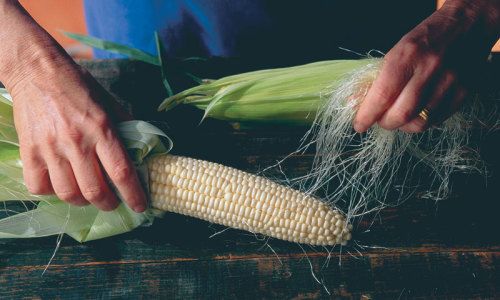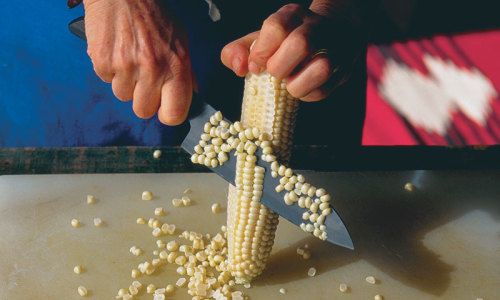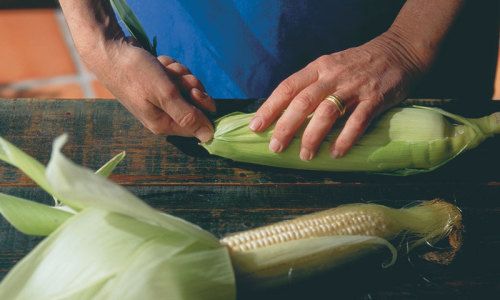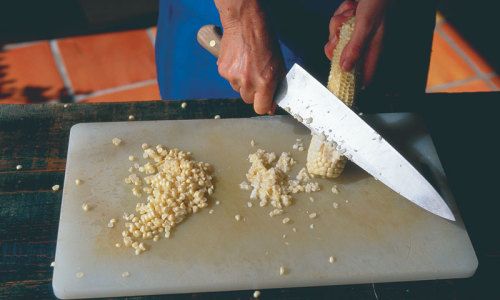
by Deborah Madison
August 1997
from issue #10
At a certain point in August in Santa Fe, shoppers at the farmers’ market start eyeing each other’s armloads and baskets of vegetables for sweet corn. Although many of our farmers grow delicious corn, everyone seems to be waiting for Don Shweybach, who drives up from the middle of the state, hauling a huge bin of long, green ears. It’s warmer where he lives, so his corn is ready first and we’re just as ready. We crowd against the bin, pick through the ears and finally buy a dozen or more. At every dinner for the next few weeks there’s sure to be corn on the table. Indeed, the season for corn is short and sweet.
In search of sweetness
When it comes to eating corn fresh, a starchy ear just won’t do. Corn breeders know this, and they’ve been trying to satisfy our appetite for sweet and tender ears since the turn of the century.
|
The dirt on corn smut When I was a kid, my father prized the fleshy fungus unappealingly called corn smut that he occasionally found growing on the ears of our field corn. He knew it was good eating, but I thought it repulsive, as most North Americans do. In Central America, however, corn fungus, or huitlacoche, is prized, as any wild mushroom is. It is used as filling for corn crêpes and tacos. Should you come across some, slice or dice it and sauté it as you would regular mushrooms. |
Sweet, sweeter, and sweetest. Their efforts have given us three types of sweet corn—regular sweet, sugar-enhanced, and supersweet. ‘Golden Bantam’, developed in 1902, falls into the first category. It combines good old-fashioned corn taste with sweetness, producing a delicious corny-tasting ear. Sugar-enhanced varieties have greater sweetness but still retain good corn character. When it comes to the supersweets, their sheer sugar density tends to eclipse the flavor of the corn itself, but they’re extremely popular with grocers because the sugars are slow to turn to starch.
I don’t notice a difference in flavor between white, yellow, and bi-colored ears, but I have noticed it’s getting harder to find yellow corn. Perhaps people think it’s starchy, but that’s not true, and I often miss the look yellow kernels give to a dish.
In spite of the lasting qualities of today’s sweet hybrids, fresh is always best. If you’re growing corn, you know you’re cooking with the freshest. But if you’re buying it, here are some tips. First, examine the husks—they should look moist and green. If they’re dried out, the kernels probably are starting to dry as well. The husks help keep the kernels fresh and moist, which is why peeling them back is discouraged by most farmers. Instead, use your hands to feel for the kernels through the husks. The rows should be well filled and the kernels plump. Many people also peel back the husks to see if the tip is wormy. Often it is—corn is very susceptible to pests—but a worm at the tip isn’t a big deal, and if it means fewer pesticides were used, all the better. Just cut off the tip and give it a rinse.
Use corn’s sweetness to full advantage
No matter how you cook it, the extra sweetness of today’s corn needs to be taken into account when it comes to seasoning. Butter, salt, and pepper are always good. Many herbs flatter corn—basil, cilantro, lovage, dill, and marjoram are a few of my favorites. Vegetables that pair well are those that share the season—tomatoes with plenty of acid, bell peppers, zucchini and other squash, and also mushrooms. Cheese lends balance, especially aged cheese that has a bit of salt in it, but also the more delicate Monterey Jack, fresh mozzarella, and fresh goat cheese. It’s chiles, though, that really complement corn’s sweetness—roasted strips of poblanos stirred into a soup, grilled New Mexico or other long, green chiles in calabacitas, or compound butter flecked with ground dried chile, minced serranos, or a bit of puréed chipotle, spread over an ear of corn.
On the cob is just about everyone’s favorite way to eat sweet corn, especially at the start of the season. Fresh ears, dropped into a pot of rapidly boiling water, need only two or three minutes to get hot and take the edge off their rawness. Don’t add salt to the water, though; that toughens the corn.
Or try grilled corn. Pull back the husks, remove the silk, then soak the ears in cold water for 20 minutes or so. Pull the husks up over the ears, twist their tops, and set them on the grill or even in the coals (photos, above). The water from soaking creates steam, which cooks the kernels. Once the kernels are cooked, you can pull back the husks and grill the ears a little longer to brown them. Salt, pepper, and a squeeze of lime add the finishing touch.
| How to prepare ears of corn for grilling | |
 |
 |
| 1. To prepare ears for grilling, peel back the outer leaves, grasp the silk, and pull it away. To remove any remaining silk, just give the ear a rub with your hands. | 2. After a 20-minute soak in cold water, put the leaves back in place and twist at the top to secure. |
Cutting the kernels off the cob gives us a lot more possibilities for using corn—in succotash, soups, stews, creamed, and in baked goods. There’s a special tool for this, but I just use a knife. Stand an ear upright, stem end resting securely on a cutting board. With a sharp knife, shave off the top halves of the kernels using a zigzag motion as your knife travels down the length of the ear. Then reverse your knife and with the dull side of the blade, repeat the motion, pressing hard to squeeze out the bottom portion of the kernels and the milk, known as the scrapings. This way you get all of the kernel and sweet juices, but none of the fibrous skins. I usually figure 3⁄4 cup of kernels from one ear, but of course this varies a bit depending on the size.
| How to cut corn kernels off the cob | |
 |
 |
| 1. Stand the ear on its end and saw down the cob, shaving off the top half of the kernels. | 2. Scrape out the remaining meat and delicious juices with the back edge of a heavy knife. |
Fine Gardening Recommended Products

A.M. Leonard Deluxe Soil Knife & Leather Sheath Combo
Fine Gardening receives a commission for items purchased through links on this site, including Amazon Associates and other affiliate advertising programs.

Chapin International 10509 Upside-Down Trigger Sprayer
Fine Gardening receives a commission for items purchased through links on this site, including Amazon Associates and other affiliate advertising programs.

The New Organic Grower, 3rd Edition: A Master's Manual of Tools and Techniques for the Home and Market Gardener, 30th Anniversary Edition
Fine Gardening receives a commission for items purchased through links on this site, including Amazon Associates and other affiliate advertising programs.























Comments
Log in or create an account to post a comment.
Sign up Log in